In the fast-paced world of modern industry, the difference between a thriving business and one crippled by downtime, accidents, and financial loss often comes down to a single, overlooked factor: proactive safety. This is the complete guide to transforming your facility from a site of hidden risks into a bastion of efficiency and resilience.
- Introduction: The Hidden Costs of an Unsafe Workplace
- Understanding the Modern Industrial Hazard Landscape
- The Pillar of a Safe Facility: Proactive Impact Protection
- A Deep Dive into SVL's Core Solutions: The "What" and "Why"
- The Irish Context: Compliance, a Culture of Safety, and the HSA
- The Business Case for Investing in Safety: ROI and Beyond
- How to Implement a World-Class Safety System: A Step-by-Step Guide with SVL
- Conclusion: Building a Resilient and Future-Proof Facility with SVL
- Act Now
- Understanding the Modern Industrial Hazard Landscape
Introduction: The Hidden Costs of an Unsafe Workplace
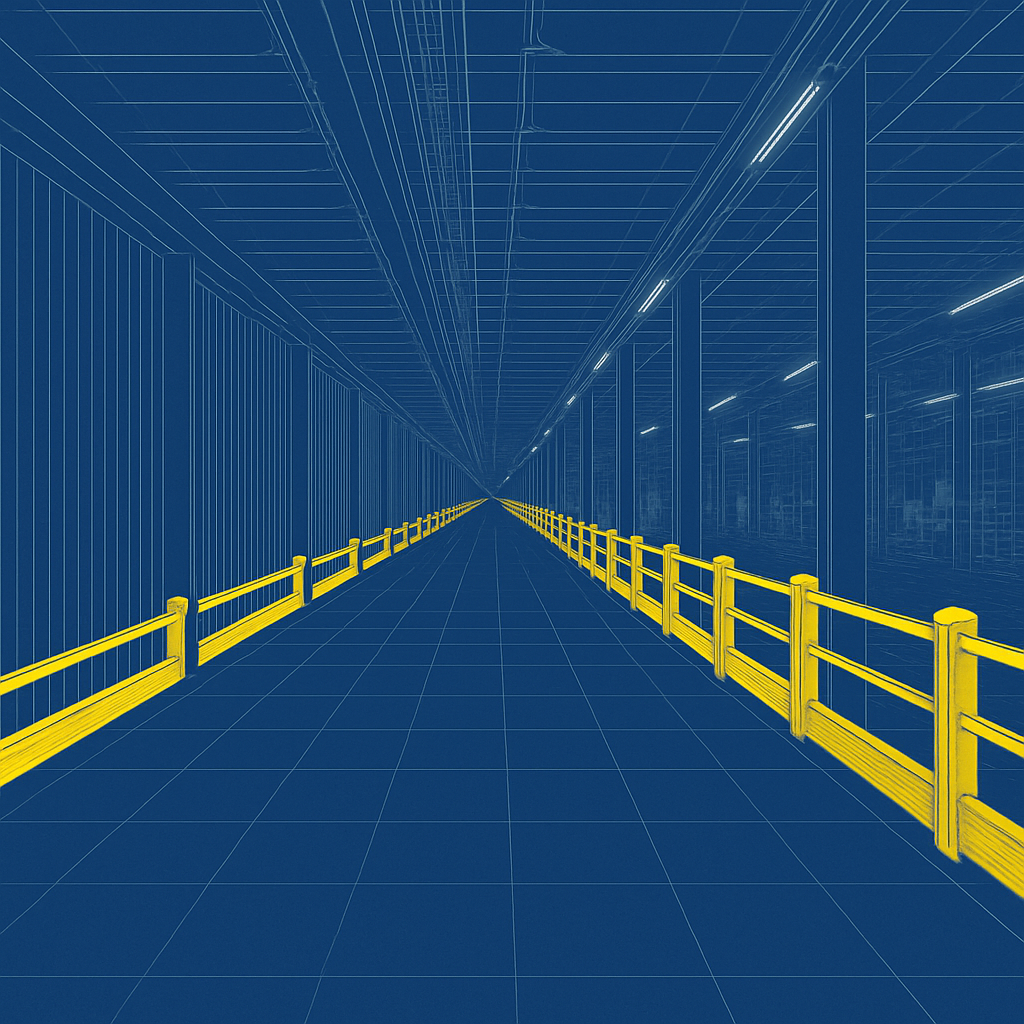
Every year, workplace accidents in Ireland cost businesses millions of euros in direct expenses, lost productivity, and legal fees. According to Ireland’s Health and Safety Authority (HSA), thousands of non-fatal injuries occur annually, with a significant portion happening in sectors like manufacturing, construction, and transportation – the very heart of our economy. But the official statistics only tell part of the story. The true cost of an unsafe workplace isn’t just in the insurance claims; it’s in the collapsed racking, the damaged inventory, the emergency repairs, the operational downtime, and the erosion of employee morale.
For too long, safety has been viewed as a cost centre – a box-ticking exercise in compliance. This perspective is not just outdated; it’s dangerous. In today’s competitive landscape, safety is a powerful profit driver. A safe facility is an efficient, productive, and resilient one. It’s a place where people are protected, assets are secure, and operations run like clockwork.
This is where the paradigm shifts from reactive repair to proactive protection. It’s about anticipating risks and engineering them out of your environment before they can cause harm. This guide will walk you through the principles of modern industrial safety, focusing on the critical role of impact protection solutions. And your expert guide on this journey is SVL Store Vision Ltd., Ireland’s leading authority in industrial damage prevention. We don’t just sell products; we engineer peace of mind.
Understanding the Modern Industrial Hazard Landscape
The modern warehouse, manufacturing plant, or retail back-of-house is a complex and dynamic ecosystem. The rise of e-commerce, just-in-time logistics, and automation has increased the speed and density of operations. Forklifts, pallet jacks, and other material handling equipment (MHE) move with greater frequency in tighter spaces, sharing floor space with an ever-present workforce.
This evolution has created a new landscape of hazards. While slips, trips, and falls remain a concern, the most catastrophic (and costly) incidents invariably involve collisions and impacts. As highlighted in the seminal article “Warehouse Safety: Protecting People, Equipment and Productivity,” the failure to control vehicle movement is a primary source of injury, damage, and productivity loss.
Let’s detail the most common and costly hazards:
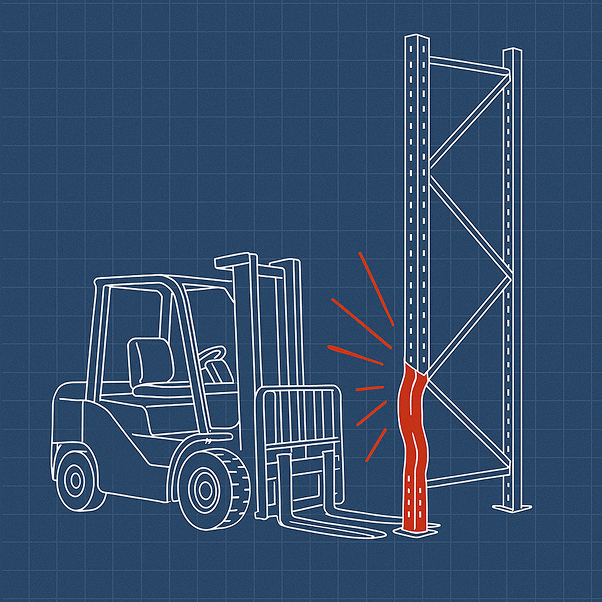
Forklift-Racking Collisions:
This is the number one threat to warehouse integrity. A low-speed impact from a multi-ton forklift can compromise a racking leg, leading to a risk of progressive collapse – a domino effect that can bring down an entire aisle, destroying thousands of euros worth of inventory and endangering lives. The cost isn’t just the repair; it’s the painstaking process of unloading the entire section, replacing the damaged components, and re-certifying the structure.
Vehicle-Pedestrian Incidents:
The most serious hazard. In busy environments, designated walkways can become blurred. A moment of inattention from a driver or a pedestrian can lead to a tragic accident. The human cost is immeasurable, and the legal and financial repercussions for the business can be terminal.
Impacts with Structural Elements:
Building support columns, door frames, and utility conduits are often in the direct path of vehicle traffic. Damage to a structural column can compromise the entire building’s safety, while a damaged door frame can halt operations in a critical part of your facility.
Loading Bay Accidents:
The loading bay is a high-traffic chokepoint where trucks, forklifts, and people converge. Uncontrolled vehicle movement, such as a truck prematurely pulling away from the dock, can lead to devastating forklift falls and other serious incidents.
These are not hypothetical “what-if” scenarios. They are daily realities in facilities that lack a robust damage prevention industrial strategy. The core problem is kinetic energy – the force of a moving vehicle – and the solution is to manage and absorb that energy safely.
The Pillar of a Safe Facility: Proactive Impact Protection
What exactly is “Impact Protection”? It is the strategic use of engineered barriers, guards, and systems to control vehicle movement, segregate people from traffic, and shield critical assets and infrastructure from collisions.
The old “fix-it-when-it-breaks” approach is a recipe for failure. It’s a strategy based on luck, and in a busy industrial environment, luck always runs out. A reactive approach means you are always one incident away from disaster. Proactive impact protection, by contrast, is a deliberate, engineered strategy that delivers a measurable return on investment.
The core components of a robust safety system are designed to absorb and deflect impact forces, protecting what’s behind them. These are not just pieces of metal or plastic; they are life-saving, cost-saving engineering tools. The essential elements include:
Guardrails & Barriers:
The foundation of traffic management. They create clear, physical boundaries between vehicle routes and pedestrian walkways or sensitive areas. As John P. Clark notes in his research, engineered guardrails are a primary strategy for preventing incursions.
Bollards: These vertical posts are the sentinels of your facility. They are used to protect corners, door frames, and expensive machinery from impacts where a full guardrail isn’t practical.
Racking Protection:
Specifically designed guards that attach to or stand off from your pallet racking uprights and end-of-aisles. They are the single most effective way to prevent the catastrophic failure of your storage systems.
Column Guards:
Protective shields that wrap around structural columns, absorbing impacts and preventing damage to your building’s essential supports.
Safety Gates:
Spring-loaded or manual gates that control access to pedestrian crossings or restricted zones, ensuring that people stop and look before entering a potentially hazardous area.
Investing in these impact protection solutions is the first and most important step in transforming your facility’s safety and efficiency.
A Deep Dive into SVL’s Core Solutions: The “What” and “Why”
At SVL Store Vision Ltd., we have spent years researching, developing, and deploying the most effective industrial safety barriers and protection systems on the market. Our solutions are not one-size-fits-all; they are tailored to the specific risks and operational needs of your facility. This section provides a deep dive into our core product categories.
Heavy-Duty Guardrails and Barriers: Your First Line of Defense
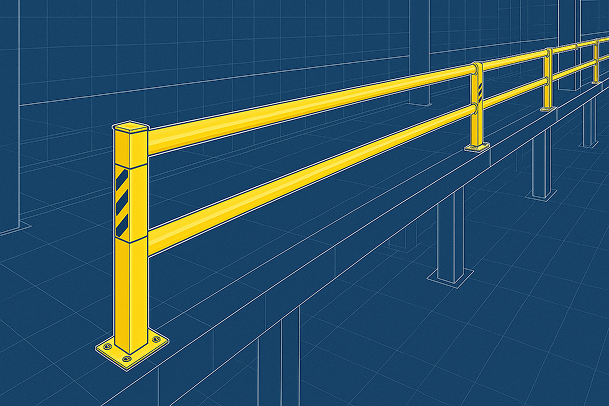
What It Is:
Our guardrails are modular, high-strength barrier systems, typically constructed from steel for maximum durability. They are designed to withstand significant forklift impacts, absorbing and dissipating the force to protect people and assets behind them.
The Problem It Solves:
They prevent vehicles from straying into pedestrian walkways, office areas, or zones with delicate machinery. They create predictable traffic flows, which is the cornerstone of pedestrian safety in warehouses.
Engineering & Benefits:
SVL’s guardrails feature a multi-rail design for protection against different impact heights (from pallet jacks to forklift forks). Their high-visibility yellow powder-coat finish ensures they are easily seen by drivers. Unlike flimsy floor markings, they provide a real, physical deterrent.
Real-World Scenario:
In a busy distribution centre, a long aisle of racking runs parallel to a main pedestrian walkway. An SVL heavy-duty guardrail is installed along the entire length, creating an impenetrable barrier. A forklift driver, momentarily distracted, veers towards the walkway. The forklift impacts the guardrail, which flexes to absorb the energy, bringing the vehicle to a safe stop. The pedestrians on the other side are completely unharmed, and a potentially fatal accident has been averted.
Polymer Safety Bollards: Flexible Strength Where You Need It Most
What It Is:
Polymer bollards are advanced safety posts made from a flexible, resilient synthetic material. Unlike rigid steel bollards that permanently deform or destroy the floor fixing on impact, polymer bollards can absorb the impact, flex, and return to their original shape.
The Problem It Solves:
They are ideal for protecting assets in high-traffic areas where incidental contact is likely. They prevent damage to door frames, corners, and equipment without requiring constant repair and replacement of the bollard or the floor.
Engineering & Benefits:
The secret is in the material science. Our polymer bollards absorb kinetic energy, dissipating it through their structure. This means less shock is transferred to the floor anchors, preventing costly concrete damage. They are self-coloured, so they never need painting and won’t show scratches.
Real-World Scenario:
The corner of a busy intersection in a manufacturing facility is constantly being clipped by forklifts, leading to chipped concrete and damaged walls. A rigid steel bollard was installed, but after two impacts, the floor anchors were ripped out, requiring expensive concrete repairs. SVL replaces it with a polymer safety bollard. Now, when a forklift makes contact, the bollard flexes, absorbs the blow, and returns to its upright position. The forklift suffers no damage, the floor remains intact, and the corner is protected. Reducing operational downtime is a direct benefit.
Racking Protection: Securing the Backbone of Your Warehouse
What It Is:
A range of specialized guards designed to shield the most vulnerable parts of your pallet racking. This includes end-of-aisle barriers that protect the entire rack end and individual upright protectors that guard each leg.
The Problem It Solves:
This directly answers the question: “How to prevent forklift damage to racking?” Racking uprights are not designed to withstand lateral impacts. Our racking protection solutions absorb the collision force, preventing it from reaching and damaging the upright itself.
Engineering & Benefits:
We offer both steel and polymer options. Steel provides brute-force protection, while polymer protectors offer resilience and energy absorption. They are designed to be installed without compromising the rack’s structural integrity and are painted in high-visibility colours to act as a visual guide for drivers.
Real-World Scenario:
A warehouse manager is concerned about the constant damage to the front legs of their racking aisles. They invest in SVL’s steel upright protectors for every exposed leg. A week later, a new driver misjudges a turn and his forklift’s blades strikes a protected upright. The guard takes the full force of the impact, suffering a dent but leaving the racking leg completely untouched. A €5,000 racking replacement job has been avoided for the cost of a €50 guard.
Column Guards: Shielding Your Structural Integrity
What It Is:
Robust, often polymer-based, guards that wrap around your building’s structural columns.
The Problem It Solves:
They prevent catastrophic damage to the pillars that hold up your roof. Repairing a structural column is an immensely expensive and disruptive process that can shut down your entire facility.
Engineering & Benefits:
Our column guards use an air-cushion or energy-absorbing foam interior to dissipate impact forces. Their clamshell design makes them easy to install with simple straps, requiring no drilling into the column itself. The bright yellow polymer is highly visible and maintenance-free.
Real-World Scenario:
In a large retail back-of-house, a main support column is located near the goods-in area. An SVL column guard is fitted. A pallet truck operator, rushing to unload a delivery, loses control and collides with the column. The column guard compresses, absorbing the impact. The operator is shaken but unhurt, the pallet truck is fine, and most importantly, the building’s structural integrity is 100% intact.
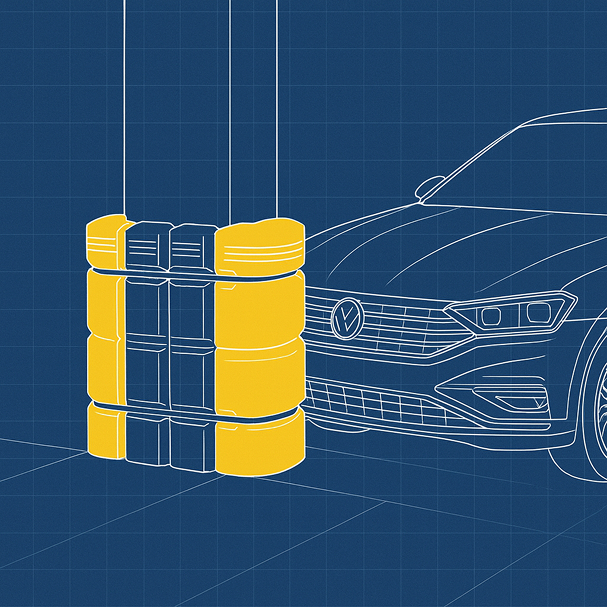
Safety Gates: Controlling Access, Preventing Accidents
What It Is:
Self-closing gates, often integrated with guardrail systems, that are placed at pedestrian crossing points or the entrance to work zones.
The Problem It Solves:
They eliminate the danger of a person walking directly from a “safe” zone into an active vehicle lane without stopping. The physical action of having to open a gate forces a moment of awareness.
Engineering & Benefits:
Our gates are spring-loaded to ensure they always return to the closed position. They are built to the same robust standards as our guardrails and finished in high-visibility colours. They are a simple, cost-effective, and highly effective behavioural safety tool.
Real-World Scenario:
A busy warehouse has a designated walkway that crosses a main forklift thoroughfare. Despite floor markings and signs, there have been several near-misses. SVL installs self-closing safety gates on both sides of the crossing. Now, employees must pause and physically open the gate before crossing, giving them a critical moment to check for oncoming traffic. The number of near-misses drops to zero.
The Irish Context: Compliance, a Culture of Safety, and the HSA
For any business operating in Ireland, a discussion about safety is incomplete without mentioning the Health and Safety Authority (HSA). The HSA is the state agency responsible for enforcing occupational health and safety law and providing guidance to businesses. Achieving compliance with HSA warehouse guidelines is not just a legal obligation; it’s a fundamental component of responsible business management.
The HSA’s guidance for warehousing and logistics is crystal clear. On their website, they explicitly identify key risk areas that SVL’s solutions are designed to mitigate:
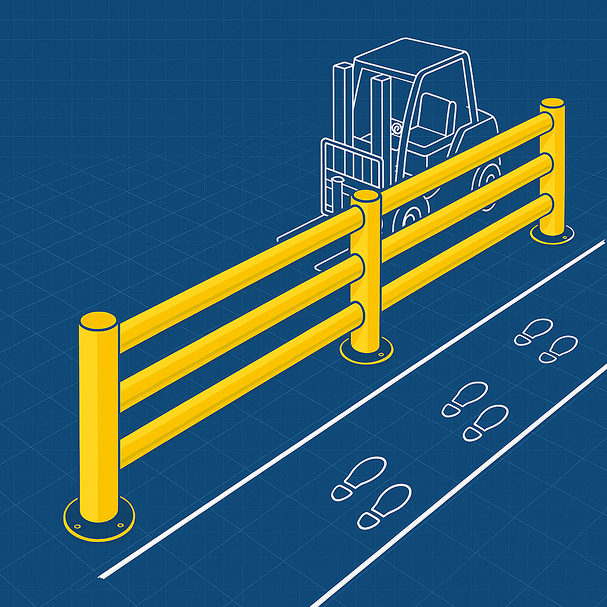
Vehicle Movement Control:
The HSA emphasizes that “the movement of vehicles in and around the workplace is a major cause of fatal and serious injuries.” They recommend segregating pedestrian and vehicle traffic routes. SVL’s guardrails and barriers are the physical embodiment of this core principle.
Pedestrian-Vehicle Interfaces:
The HSA’s “Risk Assessment Prompt Sheet for Warehouse and Stores” specifically asks businesses to consider the risks where people and vehicles interact. Our safety gates and clearly demarcated walkways directly address this.
Racking Collapse:
The HSA lists “racking collapse due to vehicle collision” as a primary hazard under storage systems. Our racking protection products are a direct and effective control measure for this specific, high-consequence risk.
Partnering with SVL Store Vision Ltd. is one of the most direct ways to demonstrate to an HSA inspector – and to your own employees – that you are serious about safety. Our systems help you move beyond mere compliance to create a genuine culture of safety.
As noted in multiple studies, including “Warehouse Safety: Protecting People, Equipment and Productivity,” a strong safety culture has a powerful secondary benefit: improved employee retention. When employees feel safe and see that their employer is investing in their well-being, morale and loyalty increase significantly. In a tight labour market, being known as a safe employer is a major competitive advantage. An investment in SVL safety solutions is an investment in your people.
The Business Case for Investing in Safety: ROI and Beyond
For the Directors, VPs, and business owners reading this, the decision to invest must be backed by a solid business case. While the moral imperative to protect your team is paramount, the financial argument for proactive impact protection is overwhelmingly positive. Let’s move beyond the abstract concept of “safety” and talk about tangible returns.
An investment in a comprehensive asset protection system from SVL delivers ROI in multiple ways:
Drastically Reduced Downtime:
What is the cost of workplace accidents in Ireland? Consider this: a single damaged racking upright can put an entire aisle out of commission for days. This means lost storage capacity, labour costs for moving inventory, and disruption to order fulfillment. The cost of a single guardrail that prevents this is minuscule compared to the cost of that downtime. A closed loading bay or a damaged structural column can halt your entire operation. Proactive protection is your insurance against this disruption.
Lower Maintenance and Repair Costs:
Compare the cost of replacing a polymer bollard with the cost of repairing a damaged concrete floor and a steel door frame – a bill that can easily run into the thousands. Every time an SVL product absorbs an impact, it saves you a repair bill. Over the lifetime of your facility, these savings accumulate into a significant sum.
Protection of High-Value Assets and Inventory:
Your racking holds your most valuable asset: your inventory. A racking collapse can result in a total write-off of thousands or even millions of euros worth of product. Similarly, our barriers can protect critical machinery, control panels, and conveyor systems, each representing a massive capital investment.
Favourable Insurance Premiums and Reduced Liability:
Insurance companies are experts in risk assessment. A facility with documented, professionally installed safety systems is demonstrably a lower risk. This can lead to more favourable insurance premiums. Furthermore, in the unfortunate event of an incident, being able to show you took all reasonable proactive measures can significantly reduce your legal and financial liability.
Enhanced Employee Morale and Productivity:
This is a powerful, if less direct, financial benefit. A safe workplace is a happy and productive workplace. When employees aren’t worried about their physical safety, they can focus better on their tasks. As research from SME on “Loss Trend Analysis” suggests, a positive safety culture reduces absenteeism and turnover, cutting recruitment and training costs.
The question is not “Can we afford to invest in safety?” The real question is “Can we afford NOT to?”
How to Implement a World-Class Safety System: A Step-by-Step Guide with SVL
Knowing you need to improve safety is one thing; knowing how to do it effectively is another. Many businesses ask, “What are the best industrial safety barriers for a warehouse?” The answer is: the ones that are right for your specific risks. This is where SVL transcends being a mere supplier and becomes your expert consultant. We guide you through a logical, data-driven process.
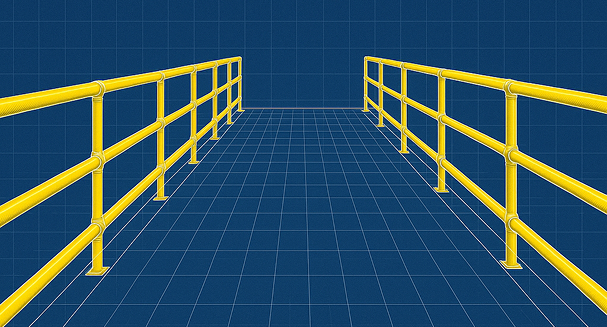
Here is our proven, step-by-step guide to implementing a world-class safety system:
Step 1: Professional Risk Assessment
The journey begins with a thorough warehouse risk assessment. An SVL safety expert will walk your facility with you to identify your unique “hot spots.” We don’t just look for obvious dangers; we analyze traffic flows, vehicle types, operational procedures, and past incidents (or near-misses). Drawing on frameworks like those discussed in studies by Hofstra et al. and the DEMATEL approach for complex environments, we help you pinpoint where the kinetic energy is and where it’s most likely to cause harm. This data-driven approach ensures that your investment is targeted for maximum effect.
Step 2: Customised Solution Design
Based on the risk assessment, we design a customised safety plan. This isn’t about selling you as many products as possible; it’s about prescribing the right solutions for the right applications. We might recommend heavy-duty steel guardrails for your main forklift thoroughfares, flexible polymer bollards around your door frames, and specific end-of-aisle racking protectors for your warehouse section. We consider your budget, your operational needs, and your future growth plans to create a scalable, effective system. This is our SVL safety solutions review for your specific site.
Step 3: Professional Installation
The best safety products in the world are useless if they are installed incorrectly. An improperly anchored guardrail can fail under impact, providing a false sense of security. Our team of experienced installers ensures that every component is fitted according to manufacturer specifications and industry best practices. We use the correct fixings for your specific floor type, ensuring that the system will perform as designed when you need it most.
Step 4: Review and Evolve
Safety is not a one-time project; it’s an ongoing process. Your facility will change over time – new machinery will be added, layouts will be altered, and workflows will evolve. We recommend periodic reviews of your safety systems to ensure they remain effective. As your partner in safety, SVL is always available to help you adapt your protection strategy to meet new challenges, reinforcing the idea that safety is a continuous journey of improvement.
Conclusion: Building a Resilient and Future-Proof Facility with SVL
We began this guide by highlighting the hidden costs of an unsafe workplace. We have journeyed through the modern hazard landscape, explored the core principles of proactive impact protection, and detailed the specific, engineered solutions that turn theory into practice.
The conclusion is inescapable: in the modern industrial, retail, and logistics sectors, safety is not an expense – it is a strategic investment in resilience, efficiency, and profitability.
A proactive approach to damage prevention industrial – built on a foundation of robust impact protection solutions – is the most effective way to protect your three most valuable assets: your people, your physical assets, and your bottom line. It allows you to meet and exceed your legal obligations under the HSA, foster a positive and productive work culture, and insulate your business from the crippling costs of accidents and downtime.
SVL is more than just a provider of industrial safety barriers and racking protection. We are your dedicated partner in warehouse safety Ireland. We bring the expertise, the data-driven approach, the world-class products, and the on-the-ground experience to transform your facility. We help you build a workplace that is not just compliant, but truly safe; not just functional, but future-proof.
Act Now
The most expensive accident is the one that is about to happen. Don’t wait for a costly incident to force your hand. Take the proactive step today.
Ready to transform your facility’s safety and efficiency? Contact the SVL Store Vision Ltd. experts today for a complimentary, no-obligation site assessment. Protect your people, protect your profits.
References
1. Clark, J. P. (2022, August 1). *Warehouse Safety: Protecting People, Equipment and Productivity*. Occupational Health & Safety. Retrieved from `https://ohsonline.com/articles/2022/08/01/warehouse-safety.aspx`
2. Health and Safety Authority (HSA). *Warehousing Safety*. Retrieved from `https://www.hsa.ie/eng/vehicles_at_work/workplace_transport_safety/warehousing_safety/`
3. Health and Safety Authority (HSA). *Stores / Warehouse Hazards*. Retrieved from `https://www.hsa.ie/eng/your_industry/health_and_social_care_sector/occupational_hazards_in_hospital_departments/department_hazards/stores_warehouse/`
4. Hofstra, N., et al. (2018). *Assessing and facilitating warehouse safety*. Safety Science, 107, 95-105. Retrieved from `https://www.sciencedirect.com/science/article/abs/pii/S0925753517308688`
5. Esmaeili, S. V., et al. (2025). *Optimizing in-store warehouse safety: A DEMATEL approach*. Heliyon, 11(7), e34006. Retrieved from `https://pmc.ncbi.nlm.nih.gov/articles/PMC11825006/`
6. Szymonik, A. (2023). *Determinants of warehouse safety – theory and practice*. Production Engineering Archives, 29(4), 469-478. Retrieved from `https://www.researchgate.net/publication/379585057_Determinants_of_warehouse_safety_-_theory_and_practice`
7. SME. (2024, March). *Improving Warehouse Safety Culture and Safety Training with Loss Trend Analysis*. Retrieved from `https://www.sme.org/technologies/articles/2024/march/improving-warehouse-safety-culture-and-safety-training-with-loss-trend-analysis1/`